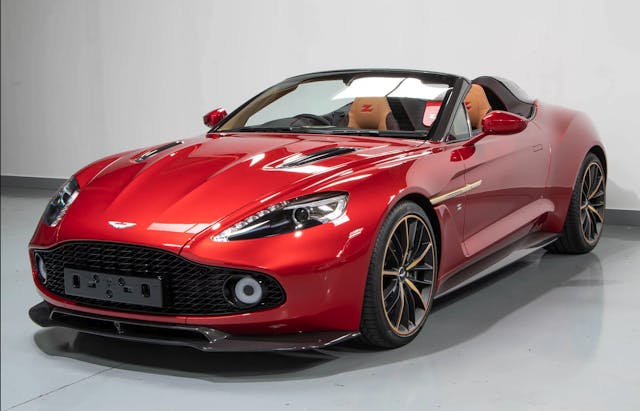Ford dreams of roofless Broncos, Travis Pastrana sniffs clouds, Aston Martin Zagato goes “cheap”
Even Ford agrees that the best Bronco doesn’t have a roof
Intake: Ford is showing yet another custom-built Bronco to highlight the myriad ways one can outfit the hot new off-roader with factory parts that suit any kind of lifestyle. This latest build is called Riptide and uses tubular doors and a surfboard rack to highlight the Bronco’s open-air potential and the fact that leaving the top off doesn’t prevent the 4×4 from offering some utility. The vinyl-trimmed seats and rubberized floor covering continue the practical outdoor theme, giving the vehicle an easy-to-clean interior.
Exhaust: Ford seems to be offering the kinds of factory parts that buyers will crave, which is exactly what we’ve been seeing from Bronco’s main rival, the Jeep Wrangler. With a second slew of hardtop-related production delays, Ford needs all the help it can get to keep up Bronco customer morale. Expect Ford to keep churning out aftermarket parts and builds like Riptide to keep customers excited about its most off-road focused product, with the next big batch coming at the SEMA show this fall.
Pastrana sets new record on Mount Washington
Intake: Travis Pastrana has just smashed his own record for the ascent of Mount Washington. Driving the Hoonigan Subaru “Airslayer” WRX STI built for his 2020 Gymkhana video, Pastrana hooned up the hillclimb 16 seconds faster than his previous record. Clocking a time of 5:28.67 for the 7.6-mile sprint up the seriously sketchy Auto Road, he averaged 83 mph. For context, the average tourist takes half an hour to make the climb. Pastrana even tops 130 mph between the trees at one stage, yet he still has time to wave to watchers on his way up.
Exhaust: With Pikes Peak now fully paved, Mount Washington is probably the most perilous hillclimb in the U.S.A. and Pastrana makes it look easy. It’s a tremendous run, but if you want to watch a really hairy hillclimb then we still think there’s nothing to touch Ari Vatanen’s incredible Cloud Dance.
This Aston Martin Vanquish Zagato Speedster is a steal

Intake: One of just 28 2018 Aston Martin Vanquish Zagato Speedsters is for sale in the U.K. at a knock-down price of $1,167,000. Originally sold for around $1,795,000 this is one investment vehicle that hasn’t exactly accelerated. The car has just 45 delivery miles on the odometer and hasn’t turned a wheel since it was put into storage immediately after the owner received it. It is finished in the same Lava Red paintwork at the Villa d’Este concept car and has bronze badges, wheel spokes and side strakes. Inside it’s all two-tone brown and tan leather with lots of red stitching and so many Zagato zees that it’ll make you want to take a nap. The Speedster is offered by Autostore in Cambridge who will happily export it anywhere in the world.
Exhaust: How the mighty have fallen. A drop of over half a million dollars in three years is pretty savage. As Aston Martin continues to create more and more limited-run cars, how will this massive depreciation impact future sales?
Jay Leno’s Talbot-Lago GSL is a mysterious racing outlier from a French family of 19
Intake: Saved from an Orange County collection after sitting for nearly sixty years, a unique piece of French coachbuilding became a member of Jay Leno’s garage last year. When this GSL first arrived in LAX, back in the ’60s, the original owner took the car home to its final resting place, where it remained parked for decades, while the original fluids (including a full tank of gas) proceeded to marinate inside it. Leno jokes around with the liberal use of the term “recommissioning,” as the GSL was certainly in need of its fair share of that and more if it were ever to see the road again. Unlike the other Talbot-Lagos of the time, Leno’s GSL sports peculiar racing alterations, such as: Weber carbs, a COMPETITION badge from the fellow French automaker Delahaye, and a transplanted manual gearbox in favor of the native Wilson pre-selector configuration.
Exhaust: Automotive history contains no shortage of mysteries, and Leno’s GSL is but another enigma that no one can seem to crack—yet. The one-of-a-kind manual is a perplexing disparity, especially considering how carefully integrated it was, which suggests a factory-quality job. Leno’s racing GSL isn’t the first (and certainly won’t be the last) example of an alluring motoring mystery left unsolved. We’re just glad some have the coin to keep many of these vehicles in the conversation while more clues come to light.
Audi’s hotter, three-motor electric SUV arrives stateside this fall

Intake: Thanks to an additional motor on the rear axle, the S-badged version of Audi’s e-tron SUV makes 74 more horsepower than the normal, two-motor version. In Boost mode, which is available for up to 8 seconds at a time, it can make a whopping 496 hp and 718 lb-ft of torque. The two rear motors can work independently to manage torque to each rear wheel, and, when grip is low or throttle demand is high, the front motor chimes in to provide all-wheel drive. Aesthetically, e-tron S models gain two extra inches of width, available 22-inch tires, and aggressive grillework. The battery pack carries over from the non-S models, however, and range is 208–212 miles, 4–8 more than the regular SUV and its Sportback variant. You’ll pay $18,900 more for the S badge when the new e-trons arrive stateside this fall.
Exhaust: U.S. buyers already get Audi’s electric SUV—both the more upright and the chop-top, Sportback version—in normal spice level, with two motors delivering 355 hp (or 402 in Boost mode). The S versions pack a herd of extra electric horsies and a price tag to match, but range doesn’t see a similarly dramatic increase. We doubt that Tesla shoppers will be converted by spiced-up e-tron SUV pair, but upmarket Audi shoppers, perhaps those with a fuel-burning four-ring model already in the driveway, may appreciate the upgrade.
U.S. DOT is officially probing why Tesla Autopilot keeps crashing into emergency vehicles

Intake: NHTSA safety regulators from the U.S. DOT are launching an investigation into how well Tesla’s self-driving and Autopilot tech interprets roadside events. A disturbing trend discloses 11 separate occasions (over the last 3 years) in which Teslas engaged with Autopilot or self-driving features struck stationary emergency vehicles, resulting in 17 injuries and 1 fatality. The report summary reads, “Most incidents took place after dark and the crash scenes encountered included scene control measures such as first responder vehicle lights, flares, an illuminated arrow board, and road cones.” The bevy of cars in question include the Model Y, X, S, and 3 manufactured between 2014 and 2021. The investigation is putting Tesla’s SAE Level 2 autonomy under review to assess “the technologies and methods used to monitor, assist, and enforce the driver’s engagement with the dynamic driving task during Autopilot operation.”
Exhaust: Technology is the champ at eliminating known human error. But replacing human interpretation of the unknown? That remains untouchable. If drivers must constantly scan when Autopilot works correctly and when it doesn’t, then “autonomy” becomes a joke. Impromptu emergency scenes are routine maneuvers for any responsible, fully functioning, and engaged driver, and tiptoeing the lines of who holds what/what holds who accountable seems like a fool’s game. If you’re in that camp, consider revisiting Moravec’s paradox covered in depth by Jack Baruth’s AC #66.


